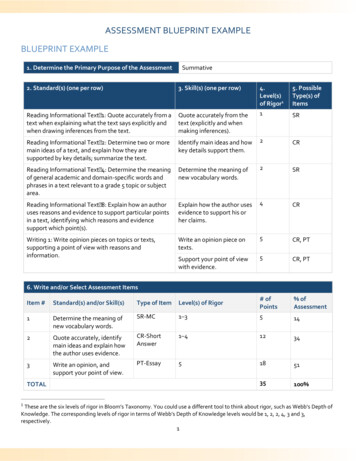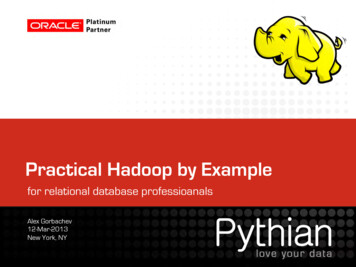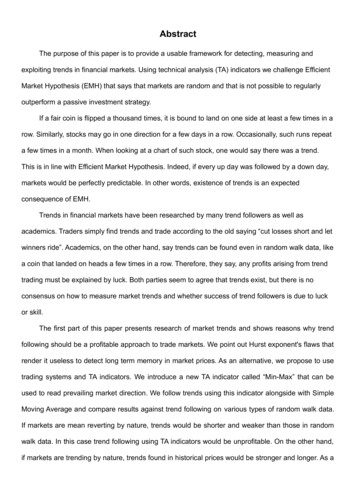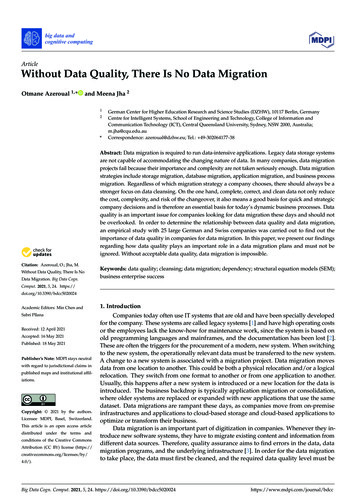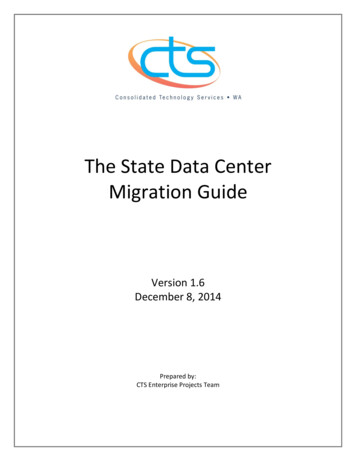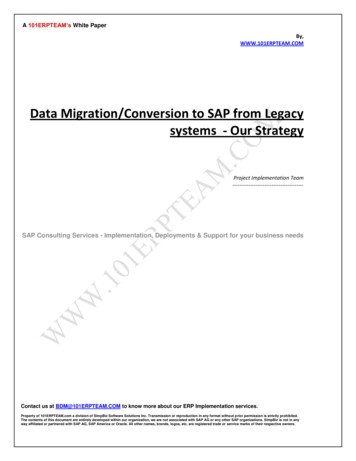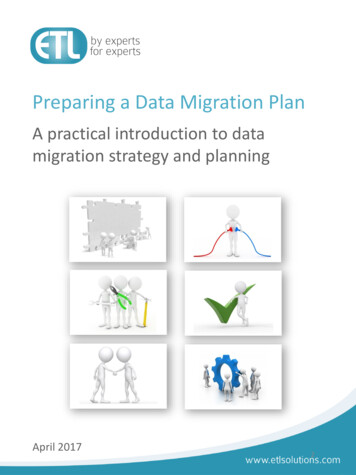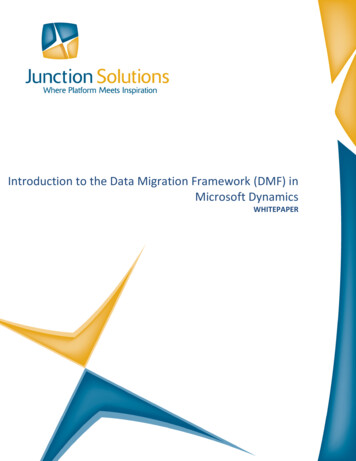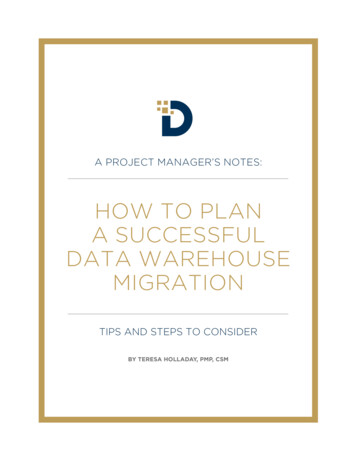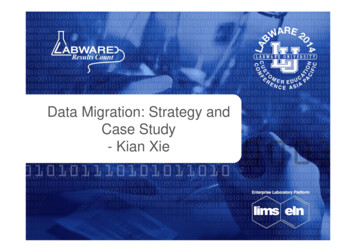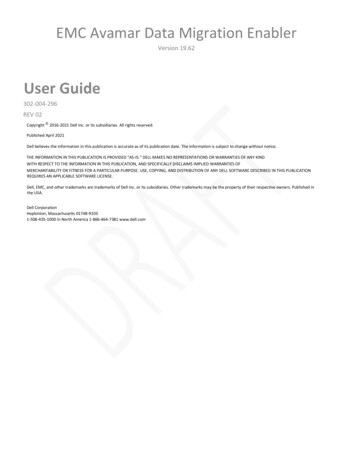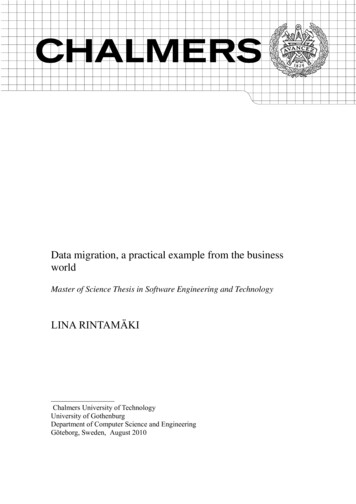
Transcription
Data migration, a practical example from the businessworldMaster of Science Thesis in Software Engineering and TechnologyLINA RINTAMÄKIChalmers University of TechnologyUniversity of GothenburgDepartment of Computer Science and EngineeringGöteborg, Sweden, August 2010
The Author grants to Chalmers University of Technology and University of Gothenburgthe non-exclusive right to publish the Work electronically and in a non-commercialpurpose make it accessible on the Internet.The Author warrants that he/she is the author to the Work, and warrants that the Workdoes not contain text, pictures or other material that violates copyright law.The Author shall, when transferring the rights of the Work to a third party (for examplea publisher or a company), acknowledge the third party about this agreement. If theAuthor has signed a copyright agreement with a third party regarding the Work, theAuthor warrants hereby that he/she has obtained any necessary permission from thisthird party to let Chalmers University of Technology and University of Gothenburgstore the Work electronically and make it accessible on the Internet.Data migration, a practical example from the business worldL. RINTAMÄKI L. RINTAMÄKI, August 2010.Examiner: P. ZARINGChalmers University of TechnologyUniversity of GothenburgDepartment of Computer Science and EngineeringSE-412 96 GöteborgSwedenTelephone 46 (0)31-772 1000Department of Computer Science and EngineeringGöteborg, Sweden August 20101
AbstractA high amount of data is being managed by databases and applications in companiestoday. In many cases data is extracted from several different databases, then managedand finally stored in yet another database. The process of moving data from onedatabase to another is called data migration. The data migration process can eventuate inseveral new problems, especially considering the high amounts of data that is beingprocessed.In some cases the data migrations are conducted manually, which can be very timeconsuming. On the software market today there exists several different 'off the shelf'products that manages the data migration process. The problem is to find the one that ismost suitable for the company, or to realize that there is none that is suitable enough.The practical work performed behind this masters thesis is the development of anapplication for data migration that is custom-made for the company Dipcon and theirspecific needs. In addition to the data migration the application also performs thetransformation of the data that is needed before the migration.The more theoretical part of this thesis is focused on the theories and practices behinddata migration. Data migration projects are very common, a clear majority of thecompanies asked in Bloor Reasearch's Data migration in the global are performing adata migration each every 3d month or more often. Even though they are so common,the data migration projects seem to be misunderstood with a more than 60% failure rate.This thesis is discussing the reasons behind this and have some suggestions to add inorder to increase the likelihood of a successful data migration.2
AcknowledgementsI would like to thank Gustav Sanders at House of Ports for the opportunity ofdeveloping there new application for the yearly invoice system, as well as for thesupport and guidance during the project.3
Table of contentsMaster of Science Thesis in Software Engineering and Technology.1Lina Rintamäki.11. Introduction.71.1 Background.71.1.1 House of Ports & Dipcon.71.2 Problem statement.71.3 Purpose and goal.81.4 Delimitations.81.5 Definitions and abbreviations.81.6 What is data migration?.102. Method.112.1 Literature study.112.2 Work method.123. Theoretical background.133.1 What is a database?.133.2 What is a domain name?.153.3Statistics and data migration success rates.163.4 Why do things go so badly wrong so often?.163.5 A data migration methodology.173.5.1 Agility in the migration.173.5.2Split the migration into two or more parts.183.5.3 Planning phase.183.5.3.1 Scoping.183.5.3.2 Profiling the data using landscape analysis.193.5.3.3 Business knowledge.203.5.3.4 Consequences of a failure.203.5.3.5 Selecting off the shelf data migration product.203.5.4 Migration phase.213.5.4.1 Export phase.213.5.4.2 Transformation phase.223.5.4.3 Import phase.233.5.5 Validation phase.234. The application.244.1 Introduction.244.1.1 Database structure.244.1.2 Languages/Tools.264.2 Design.274.2.1 Database layer.274.2.2 Persistence layer.284.2.3 Business layer.284.2.4 Presentation layer.294.2.5 Helper and utility classes.294.3 Functionality of the extraction and transformation of data (Step 1 & 2).294.3.1 Extracting data.304
4.3.2 Fee calculations.314.3.2.1 DMS fee.324.3.2.2 REN fee.334.3.2.3 HOST fee.334.3.2.4 Recalculation of data .354.3.3 Loading data.354.3.4 Presentation of the created debts.364.3.5 Testing .374.4 Functionality of the transformation, migration and verification (Step 3 & 4).384.4.1 Extracting data.394.4.2 Transformations.394.4.3 Currency conversion.404.4.4 Loading data.404.4.5 Verification.414.4.6 Testing.414.5 GUI.414.6 Encountered problems.414.6.1 Database inconsistencies.424.6.2 Language related problems.424.6.3 Other problems.436. Discussion & conclusion.445
1. IntroductionThis is a masters thesis conducted at the masters programme Software Engineering andTechnology at Chalmers University of Technology in cooperation with the companyHouse of Ports.It concerns a practical example of a data migration project between two databases, aswell as the theory and practice behind data migration. The practical example consists ofa display and review of an assignment from the company House of Ports and theiraffiliate Dipcon. The assignment was to develop an application that can manage theyearly invoices of Dipcon and involves a data migration of the invoices.1.1 BackgroundA majority, if not all, companies today uses a database system of some sort and managesa high amount of data. In some cases the data has to be transferred to another databasesystem, that process of transferring data is called data migration. Since it takes anincredible amount of time to transfer the data manually, several software products hasbeen developed that manages different data migrations. However, it can be hard to finda suitable off the shelf product so sometimes a data migration application has to becustom made and developed in house. The application developed for Dipcon is of thelatter.1.1.1 House of Ports & DipconThis thesis has been developed in a close cooperation with the Swedish company Houseof Ports.House of Ports is a company that combines five different business areas and offersproducts and services within domain names, trademarks, jurisprudence, consulting,design and hosting. The affiliated company of the concern House of Ports that will beusing the resulting application of this work is called Dipcon, domain and intellectualproperty consultants.Dipcons business area is to assist other companies with the administration of domainnames and trademarks and also consultant services like dispute resolutions, strategiesand trademark registrations. Each year an yearly invoice is sent out to all of theircustomers.The system they have been using up until now is not well suited for the increasedamount of data that has come with the expansion of the company. This has resulted in aneed for a lot of manual work when the yearly invoices have had to been sent out.Therefore a new system for managing the yearly invoices is required.1.2 Problem statementThe problem discussed in this thesis is how to increase the likelihood of a successfuldata migration. A hands on approach has been used, where a data migration project has6
been conducted. In order to provide a solution to the problem, general theory andpractice behind data migration is discussed as well.In addition to the data migration, the developed application also manages thecomputations of the data that is required for the calculations of Dipcons yearly invoices.1.3 Purpose and goalThe purpose of this thesis is to provide a wider understanding of the challenges facesdduring a data migration between different systems through a review of a practicalexample and discussion about the difficulties and risks involved.The specific goal is to develop an application that manages Dipcons yearly invoicesystem.1.4 DelimitationsThere is sev
It concerns a practical example of a data migration project between two databases, as well as the theory and practice behind data migration. The practical example consists of a display and review of an assignment from the company House of Ports and their affiliate Dipcon. The assignment was to develop an application that can manage the yearly invoices of Dipcon and involves a data migration of .
